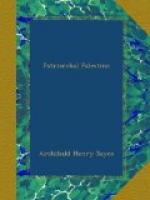In course of time the geographical signification of the name came to be widely extended beyond its original limits. Just as Philistia, the district of the Philistines, became the comprehensive Palestine, so Canaan, the land of the Canaanites of the coast and the valley, came to denote the whole of the country between the Jordan and the sea. It is already used in this sense in the cuneiform correspondence of Tel el-Amarna. Already in the century before the Exodus Kinakhna or Canaan represented pretty nearly all that we now mean by “Palestine.” It was in fact the country to the south of “the land of the Amorites,” and “the land of the Amorites” lay immediately to the north of the Waters of Merom.
In the geographical table in the tenth chapter of Genesis Canaan is stated to be the son of Ham and the brother of Mizraim or Egypt. The statement indicates the age to which the account must go back. There was only one period of history in which Canaan could be geographically described as a brother of Egypt, and that was the period of the eighteenth and nineteenth dynasties, when for a while it was a province of the Pharaohs. At no other time was it closely connected with the sons of Ham. At an earlier epoch its relations had been with Babylonia rather than with the valley of the Nile, and with the fall of the nineteenth dynasty the Asiatic empire of Egypt came finally to an end.
The city of Sidon, we are further told, was the first-born of Canaan. It claimed to be the oldest of the Phoenician cities in the “lowlands” of the coast. It had grown out of an assemblage of “fishermen’s” huts, and Said the god of the fishermen continued to preside over it to the last. The fishermen became in time sailors and merchant-princes, and the fish for which they sought was the murex with its precious purple dye. Tyre, the city of the “rock,” which in later days disputed the supremacy over Phoenicia with Sidon, was of younger foundation. Herodotus was told that the great temple of Baal Melkarth, “the city’s king,” which he saw there, had been built twenty-three centuries before his visit. But Sidon was still older, older even than Gebal, the sacred city of the goddess Baaltis.
The wider extension of the name of Canaan brought with it other geographical relationships besides those of the sea-coast. Hittites and Amorites, Jebusites and Girgashites, Hivites and the peoples of the southern Lebanon, were all settled within the limits of the larger Canaan, and were therefore accounted his sons. Even Hamath claimed the right to be included in the brotherhood. It is said with truth that “afterwards were the families of the Canaanites spread abroad.”




